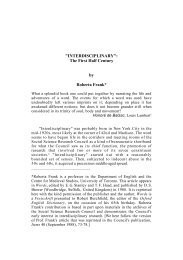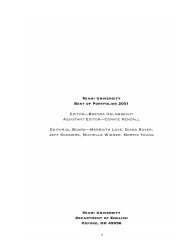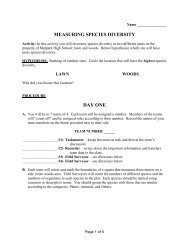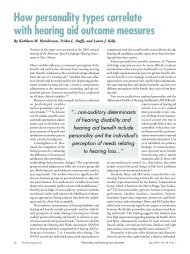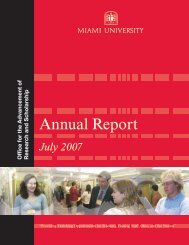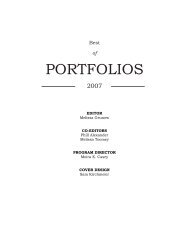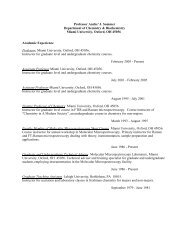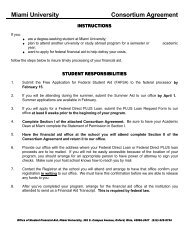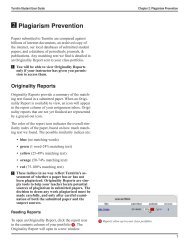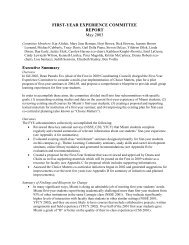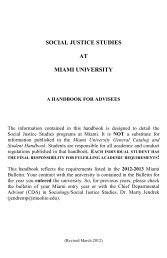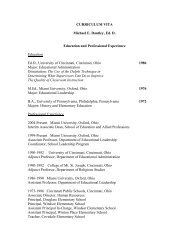Interdisciplinary Research Manual - Units.muohio.edu
Interdisciplinary Research Manual - Units.muohio.edu
Interdisciplinary Research Manual - Units.muohio.edu
You also want an ePaper? Increase the reach of your titles
YUMPU automatically turns print PDFs into web optimized ePapers that Google loves.
31<br />
remove anything you’ve written at any point in your project—put the information in a<br />
discard file in a graveyard folder, simply because you may change your mind later and<br />
decide something you discarded earlier is useful after all.<br />
If the book is an anthology, then the table of contents should reveal the topics<br />
covered. If only a couple chapters are of interest, then normally you can treat them like<br />
journal articles and read only the abstract (or introduction if there is no abstract). The<br />
exception is the occasional zealous editor whose introduction synthesizes the<br />
contributions of individual authors into an original piece of scholarship. The<br />
overwhelming majority of editors, however, write an introduction that is a mindless<br />
recitation of the main point of each contributor as the contributors saw it; the editors add<br />
little if anything new so you don’t need to waste your time on them. On the other hand, if<br />
there are a dozen chapters of interest to you, it’s likely that the anthology has some<br />
coherence; indeed it’s focused in a way you care about. In that case, you do have some<br />
interest in the volume as a whole, and you should treat it that way in your lit review,<br />
while still making reference to specific contributing authors.<br />
Some of the books in your annotated bibliography may be reference works that<br />
provide basic background on your project but do not address issues raised in the project.<br />
Normally you wouldn’t include them in your lit review, unless you have a creative<br />
portion of your project and those books address the process of carrying it out. For<br />
example, if you’re directing a play, those reference works may address how to set up a<br />
budget, where to find costumes, how to audition the cast, etc. In that case, I suggest<br />
including a section in your lit review in which you list the tasks and identify which books<br />
address each task. List them in the order you’ll need them, so that section of your lit<br />
review then becomes a time line for the creative portion of your project. This is an<br />
example of adapting the lit review so that it becomes as useful a tool as possible for your<br />
project, in this case supporting the creative as well as the analytical portion of your<br />
project.<br />
If you find yourself arguing that you need only one book coming out of a<br />
particular perspective with which you disagree because the others written from that<br />
perspective are ‘all the same’, then a red flag should pop up for you. You need to take<br />
seriously perspectives that you don’t like, such as perspectives that are politically rightof-center,<br />
sexist, or modernist. You don’t need to embrace them uncritically, but you<br />
need to look for the kernel of truth in them, for their insights that ring true to intelligent<br />
people with whom you disagree. Saying they all look alike is reminiscent of Ronald<br />
Reagan who quipped, “If you’ve seen one redwood, you’ve seen them all” or of whites in<br />
the 1960s who observed that all blacks looked the same to them. Today we find such<br />
claims abhorrent. Yet when you observe that all adherents of a particular perspective look<br />
alike, that’s because you too are looking through the lens of the opposing perspective.<br />
Like claims about redwoods or blacks, you are betraying an ignorance of the competing<br />
perspective. When you lump together people from a competing perspective and say that<br />
the differences between them are unimportant, you are, in effect, saying ‘all that counts is<br />
what I believe is important’. You can still have convictions, but bracket them, set them to<br />
one side, while you try to understand the other perspective. To do that, you need to take<br />
off the lens of the perspective you prefer so that you can put on the lens of the competing<br />
perspective. Look at those authors in their own terms, so that you understand them as<br />
they see themselves. Then you will discover there are differences among them,



